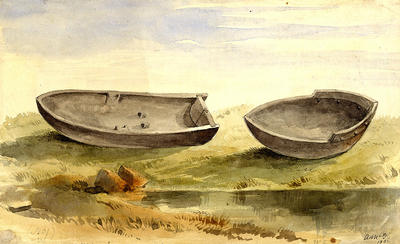
A watercolour by Andrew McGeorge depicting two of the five logboats found at Clydehaugh in August 1852, probably during the construction of General Terminus Quay. The boats are of an unsophisticated type used in Ireland and Scotland from prehistoric times until the 15th or 16th centuries. They could have been used for fishing, or simply for transportation along the River Clyde.
The boat shown on the left was 4.3 metres in length, 1.3 metres in beam and 60 centimetres in depth and was made of oak. It had been constructed by digging out a log and closing the stern with a three-piece jointed transom. Edged tools, including a large saw, had been used in its construction. The two foot-rests and the side projections suggest that this was a rowing boat.
The boat on the right was 3.1 metres in length, 1 metre in beam and 30 centimetres in depth, and was probably a canoe. A washboard or partial strake had been added to the forward portion of the boat. A hole on one side had been carefully repaired with a wooden patch. Neither of these logboats has survived.
Reproduced with the permission of Glasgow City Council, Glasgow Museums
Keywords:
archaeology, canoes, General Terminus Quay, logboats, quays, River Clyde, rowing boats, watercolours
You have 1 image in your photo album.